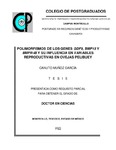| dc.description.abstract | La especie ovina presenta gran variabilidad genética, a nivel inter- e intra- raza, en las variables reproductivas tasa ovulatoria y prolificidad; y entender las causas que originan que estas variables sean elevadas en algunas razas ovinas prolíficas, ha permitido identificar a los genes de la fecundidad que participan en la función ovárica. Estos genes pertenecen a la familia del factor de crecimiento transformante tipo β (TGF β); tales como la proteína morfogénica ósea 15 (BMP15), el factor de crecimiento y diferenciación 9 (GDF9) y el receptor de la proteína morfogénica ósea tipo 1B (BMPR1B). En México, la oveja Pelibuey es la raza de pelo de mayor distribución, no obstante, tiene gran variabilidad en tasa ovulatoria y prolificidad por lo que es necesario realizar estudios de estos genes que están relacionados con estas variables reproductivas. Así, los objetivos de esta investigación fueron amplificar los genes BMP15 y GDF9, buscar sus polimorfismos, clasificar a las ovejas de acuerdo a su genotipo, determinar la relación de los polimorfismos con tipo de parto y medir tasa ovulatoria y prolificidad de acuerdo al polimorfismo que tiene influencia en estas variables reproductivas en ovejas Pelibuey. Eva Las secuencias de BMP15 y GDF9 se obtuvieron de muestras sanguíneas recolectadas en tarjetas WhatmanTM FTATM de 94 ovejas Pelibuey multíparas con registros reproductivos. Se analizó la calidad de las secuencias, se realizó su alineamiento y se hizo el análisis de polimorfismo. El 70.2% de las ovejas amplificaron BMP15 y GDF9. El análisis de polimorfismo a nivel de nucleótidos en los exones 1 y 2 de BMP15 no fue diferente y, en el exón 2 de GDF9 se identificaron los polimorfismos G2, G3, G4, G5, G6 y FecGE; de estos, G2, G3 y G5 son mutaciones sinónimas, en tanto que G4, G6 y FecGE son mutaciones no sinónimas y de éstas sus genotipos no tuvieron relación con el tipo de parto. El polimorfismo que tuvo efecto en las variables reproductivas fue FecGE y de este, las ovejas del genotipo mutado GG tuvieron 1.2 y 1.7 más cuerpos lúteos y 0.8 y 1.0 más corderos por oveja, que el genotipo silvestre AA y grupo sG, respectivamente. _______________ POLIMORFISMOS DE LOS GENES GDF9, BMP15 Y BMPR-IB Y SU INFLUENCIA EN VARIABLES REPRODUCTIVAS EN OVEJAS PELIBUEY. ABSTRACT: The ovine species presents great genetic variability, at the inter- and intra-breed level, in the reproductive variables, ovulation rate and prolificacy; and understanding the causes that cause these variables to be elevated in some prolific sheep breeds, has made it possible to identify the fertility genes that participate in ovarian function. These genes belong to the family of transforming growth factor type-β (TGFβ); such as bone morphogenic protein 15 (BMP15), growth and differentiation factor 9 (GDF9), and bone morphogenic protein receptor type 1B (BMPR1B). In Mexico, the Pelibuey sheep is the most widely distributed hair breed, however, it has great variability in ovulatory rate and prolificacy, so it is necessary to carry out studies of these genes that are related to these reproductive variables. Thus, the objectives of this research were to amplify the BMP15 and GDF9 genes, search for their polymorphisms, classify ewes according to their genotype, determine the relationship of polymorphisms with type of parturition and measure ovulation rate and prolificacy according to the polymorphism that has an influence on these reproductive variables in Pelibuey sheep. The BMP15 and GDF9 sequences were obtained from blood samples collected on WhatmanTM FTATM cards from 94 multiparous Pelibuey sheep with reproductive records. The quality of the sequences was analyzed, their alignment was carried out and the polymorphism analysis was carried out. 70.2% of the sheep amplified BMP15 and GDF9. The analysis of polymorphism at the nucleotide level in exons 1 and 2 of BMP15 was not different and, in exon 2 of GDF9, polymorphisms G2, G3, G4, G5, G6 and FecGE were identified; of these, G2, G3 and G5 are synonymous mutations, while G4, G6 and FecGE are non-synonymous mutations and of these their genotypes were not related to the type of delivery. The polymorphism that had an effect on the reproductive variables was FecGE and from this, the sheep of the mutated GG genotype had 1.2 and 1.7 more corpora lutea and 0.8 and 1.0 more lambs per sheep, than the wild genotype AA and group sG, respectively. | es_MX |


